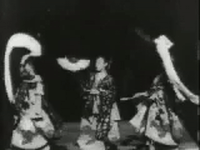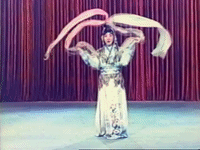
Pardee School of Global Studies
Center for the Study of Asia
presents
Dance at the World’s Fairs
The Moving Image of Asia
Dance as a form of performing arts has been part of the world fairs as early as the 1870s. Until the middle of the nineteenth century, knowledge about non-occidental dance had been mostly based on travelers’ reports. Theophile Gautier (1811-1872) reported enthusiastically in 1838, that he saw four women dancers from Pondicherry in India. To describe his impression, he used comparisons with familiar aspects of dance. The Malabou was likened to “a kind of Jota from Aragon in Spain,” while the dance “Shiva’s toilet” “resembled a Mazurka.” He did not realize that he saw a narrative dance where the interpreter illustrates a sung text with her face and hands.[1] Since then, however, what was at the time called “Oriental dance” which included Asian, Near Eastern, South-east European and North African dance, became accessible to the broader public, first through traveling performers and then through world fairs and colonial exhibitions. By 1900, it had become a major feature at these fairs. Together with art and music, dance from foreign lands, furthermore, became ever more important as Western artists and performers were presenting their own work while also looking for inspiration. When preparing a presentation of local cultures from Asia at the world’s fairs, the Asian and Western organizers and artists adjusted these presentations in anticipation of European and American audiences’ reception.
Some eastern countries such as Japan, Thailand, Korea, or China used these exhibitions to present their culture for the first time on the international scene. Their participation in these fairs was primarily motivated by their desire to familiarize themselves with state of the art of technology, but they also felt prompted to use the inclusion of culture into these fairs to bring the best they had to offer to the world. Although the initiative to bring local Asian cultures of colonized countries to the fairs often came from enterprising European individuals with local experience and contacts, they were not agents of the given colonial government. These men saw the cultural and commercial potential of local performers and thus played the role of cultural brokers. For the millions of mostly Western visitors to these fairs, the Asian arts and crafts presented there offered a first window to the world. Dance was very much part of this. For example, the Paris Exposition of 1900 saw Japanese, Javanese, and Khmer dancers, Chinese Peking Opera troupes, Japanese kabuki theater, gamelan orchestras, as well as stars of the just emerging modern dance like Loïe Fuller performing with “oriental” dancers such as the Japanese Sada Yacco.
The European fascination with the mysterious “Orient” for art and stage performances goes back several centuries, but now it could for the first time draw on live performances, a greater variety of works, and a gradually expanding knowledge of the cultural context of these works and performances. The art of the Far East had already been a big attraction of the Paris Exposition of 1878, but the Exposition Universelle eleven years later in the same city offered not only an entire “Palace of Fine Arts” of European provenience, but also a veritable universe of oriental culture that included various dance performances. The 1900 Exposition Universelle put dance center stage with a grand “Palais de Danse” and took a step to overcome the exoticization of “oriental” dance and recognize dance as a global language of cultural communication by including it in the performances offered there.
Millions of visitors journeyed from different countries and cultures to these fairs to experience the excitement of the unknown. Among the many who listened and looked were the budding artists of the future who were looking for inspiration to get out of what they saw as a dried-up academic art scene in their own cultural environment. Debussy, Rodin, van Gogh, Picasso, Puccini or Matisse all belonged to this group – apart from the painters
and craftsmen of the budding Art Nouveau scene. Quite independent of the power asymmetry as visible in the fact that the early fairs were all located in Western industrialized countries, these international expositions were thus places of a rich and largely unforeseen transcultural exchange and enrichment on all levels.
Dance became one of the major languages of this cultural communication and exchange. Even though the dance movements and gestures were coded in the symbolic language of local culture that was unfamiliar to most visitors of these fairs, the grace, the beauty, the force, the mystery, and the refinement of these dances carried beyond the first thrill of curiosity. From the audiences’ persistent fascination with these dances it is clear that the ‘moods’ conveyed by the performers touched them and gave them a glimpse of the spirit and the sophistication of a foreign culture that had hitherto been inaccessible to them. In such a first exposure, the differences between different “oriental” dances remained often blurred. This was true for both sides, the “oriental” finding its counterpart in the “Western.”
This segment of Asia at the World’s Fairs: An Online Exhibition of Cultural Exchange will focus on the interaction between Asian and Western dance that was facilitated and promoted by the presence of performers from both sides at the world’s fairs. It will follow in some detail how the inspiration from these fairs led to the inclusion of oriental dance elements into modern dance and the recasting of Peking Opera to include dance as a new and central element.






